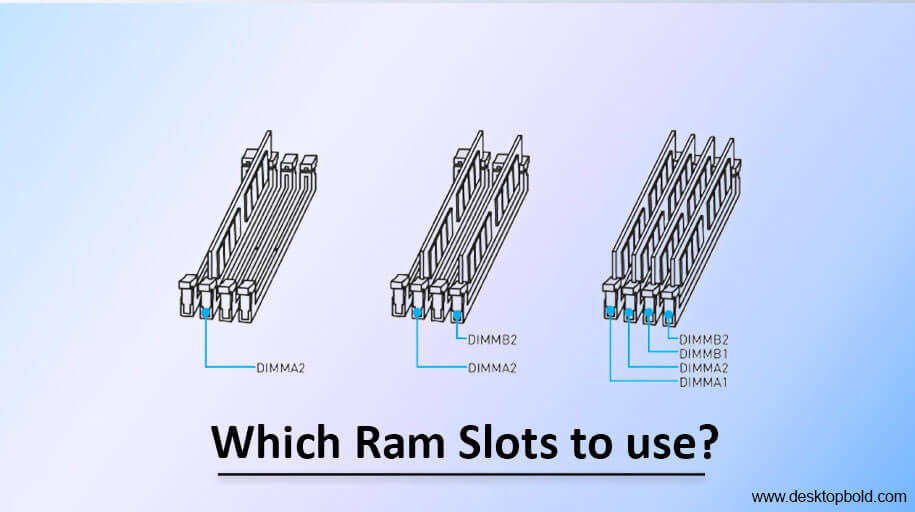It is essential to know which RAM slots to use. You are requested to see the do’s and don’ts when building a new computer. A warning appears when you download the RAM sticks on the motherboard.
It depends on two main things, the first one is you have what motherboard and the second one is you have how many RAM sticks? Due to today’s technology, whether two or more sticks are there to start the slots is fine. I will tell you about the spaces to use. You should go for the second slot if you have a motherboard with 4 RAM slots. In case of having another stick, select the fourth slot and, at last, select the first and third slots.
To enable the dual Channel and determine the required space, your best friend is the motherboard’s manual. It means to you that you have more slots. With faster CPU making to access the modules of RAM then, Dual Channel is crucial.
What is Dual Channel RAM Technology?
The dual Channel lies under the term of Multi-Channel memory automation. Through two independent sixty-four-bit buses or the highways of information in casual terminology is the technology by which the memory of a CPU accesses. Data transference occurs between the Single Channel memory and the central processing unit due to Dual Channel memory. The technologies of RAM are also available for triple and quad channels. Commercial PCs support only dual-channel memory as they are all used to support dual-channel memory.
If you want Dual Channel automation to function, then you are required to:
- Must possess two DDR, DDR2, DDR3, DDR4, or DDR5 sticks of RAM.
- Dual Channel technology-based CPU
- I have a motherboard with Dual Channel technology based.
- In the right RAM slots, keep two RAM sticks.
Single vs Dual Channel Memory Performance Comparison
Compared to single-channel RAM, the performance of Dual Channel RAM is not double in benefit as far as the performance is concerned.
A comprehensive study is done based on performance comparison by Gamers Nexus. Testing often done for the performance of single and dual-channel RAM is shown by the graph mentioned below, which may include the read, copy, write and memory bandwidth as a benchmark. When I compared a single channel RAM with Dual channel RAM, I observed a thirty per cent improvement in the performance of Dual channel memory. If you notice that your motherboard and central processing unit can support Dual Channel memory, you should go for it rather than choosing Single Channel.
There is no need to spend more money on Dual Channel; though you observe the difference in performance but not so important that the result will always be thirty per cent; the variations can also occur. Along with this information, which ram slots to use for dual channels is also evident.
Do RAM Slots Matter?
It eventually depends on whether the placement of RAM matters or not. Do you have just one RAM? So, no worry about where to place it.
In case of having more than one RAM, it will create a problem for you, and it will matter where you should place them and in which order.
Multi-channel memory architecture is a thing which makes it unique in way that if you are having the sticks more than two, you can use them all together rather than using them one by one. When you use them at once, they will be dual, triple and quad Channels. In this way, it will give a faster performance, and if it functions alone, it may take a long time to work.
The data stored in your computer RAM gets doubled, tripled or quadrupled effectively. It is the rate at which the CPU accesses your data.
Yet, in actuality, this does not translate to double the speed. Based on how much memory your program uses, you will experience performance gains; however, these gains are not linear.
RAM Modules must insert into the correct slot for this procedure to function; any old RAM slot will not do.
So, suppose you install RAM modules in the wrong slots on a motherboard that supports dual- or more-channel setups. In that case, the system will default to using only one memory channel, significantly reducing performance.
Which RAM Slots to Use?
For a motherboard to overlook, the right way is to regulate which RAM slots to use on the motherboard, and it depends on the kind of motherboard you are having as the sticks of RAM positioning change.
Use the RAM slot farthest from the CPU socket if you only have one Memory module. Your CPU setup will be the coolest if you do this. Which ram slots to use, two sticks? The answer is two RAM sticks should install in places A1 and B1, or A2 and B2, with A1 being the slot farthest from the Computer motherboard and B2 being the one closest to it.
Place all three sticks in the farthest slots from your CPU to get the most out of your RAM. A four-slot motherboard will accommodate all four memory sticks.
Which Ram slots to use, three sticks?
Place the three Memory modules in the slots closest to each other and farthest from the CPU. You may consult your motherboard’s user manual if quad-channel memory is supported to determine the proper configuration for your four RAM modules. You can arrange the four in a row or scatter them throughout the room.
Does it matter which Ram Slot to use?
It does make a difference. You must insert the RAM modules into the correct slots for the Dual Channel technology to function.
You can determine which memory slots to put your RAM in one of two ways.
1. Use the Motherboard Manual to Determine Which RAM Slots to Use First
It is the only reliable method of determining which Memory slots should house your modules.
The following is a screen capture from the user guide for the ASUS ROG Reticle VII Hero motherboard.
These are some system requirements and recommended upgrades for this motherboard:
Use the DIMM A2 slot for a single Memory module (4th slot).
DIMM A2 and DIMM B2 (the second and fourth memory slots) would allow for dual-channel operation.
Put all but one of the RAM sticks in use if you have four. Having this capability would allow for TWO SETTINGS of dual Channel.
2. Using RAM Slot Color Codes (Older Motherboards)
The RAM slots are colour coded on some motherboards (often older ones) that allow Dual Channel. For this reason, if you own two RAM modules, you should install them in slots of the same colour.
For instance, on the motherboard mentioned above, filling slots 1 and 3 with dual-channel memory would be optimal, whereas filling slots 2 and 4 with two sets of dual-channel memory would be optimal. Recent motherboards have a trend of coloring their RAM slots black for “visual appeal,” making this method ineffective for all save the oldest boards.
Can You Mix and Match RAM?
Generally speaking, this must function if the various RAM modules have similar enough specifications. But, I would not suggest using RAM modules from different manufacturers.
Rather than buying individual sticks of RAM later on, try purchasing a kit that contains as much RAM as you expect to need.
It’s probably going to work, but you may have stability issues due to effectiveness to-dos and the like, and those might be a bit—challenging to detect. Seeing random blue screens while trying to work or play is annoying.
Conclusion
We’ve covered in this post how to determine which RAM slots to use on your particular PC. If a RAM slot generates problems and makes things difficult for your computer operations, we have also gone through the different solutions you can implement. We hope that one of these solutions worked for you and that you can allot more memory to resolute activities.
Frequently Asked Questions
Which RAM Slot to Use?
Look at the motherboard’s instructions to learn which slot you should activate first. The RAM slot should insert into the second available slot, the fourth, the first, and finally, the third slot.
How Do I know if My RAM is Dual-Channel?
When purchasing RAM, don’t ask whether the modules are dual channels. The motherboard and the processor determine double, triple, or quad-channel support. Every RAM module can function in a single, dual, triple, or quad Channel with a motherboard that can accommodate the technology.
What if You Have Three RAM Sticks?
A suggestion is that while assembling a computer, the amount of memory sticks is an even number. There should be no problems with three RAM sticks; however, only one or none of them may take advantage of Dual Channel technology.
It all boils down to how well the motherboard takes advantage of the asymmetrical memory layout afforded by FLEX Mode. This setup should provide no problems for today’s motherboards and processors. Because of this, in Flex mode, two memory sticks will function in Dual Channel mode, while the third will perform in a single Channel.




